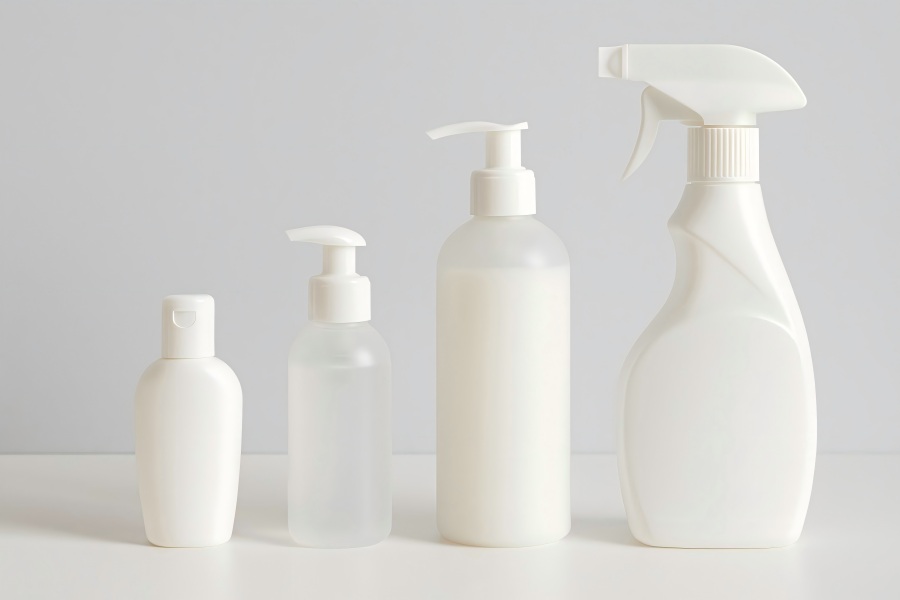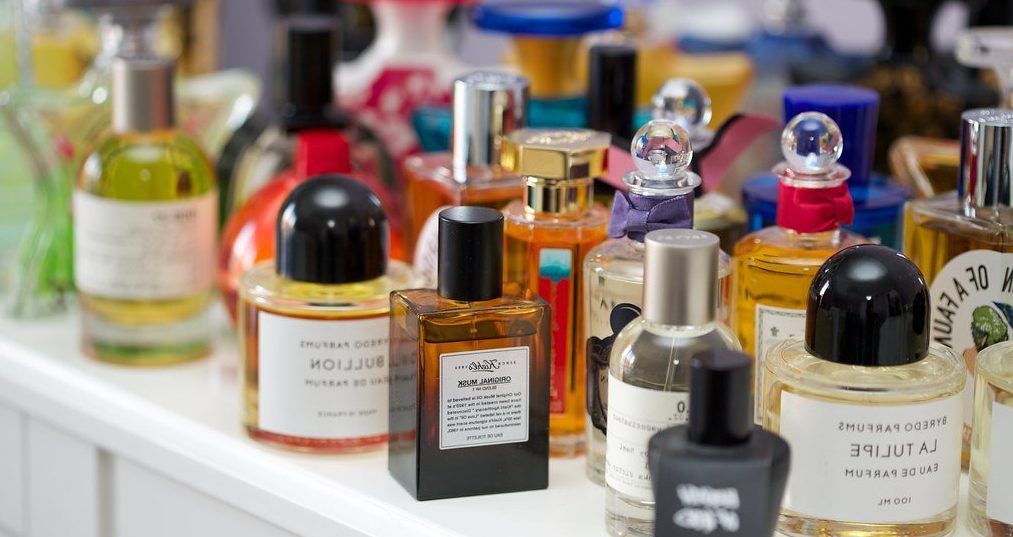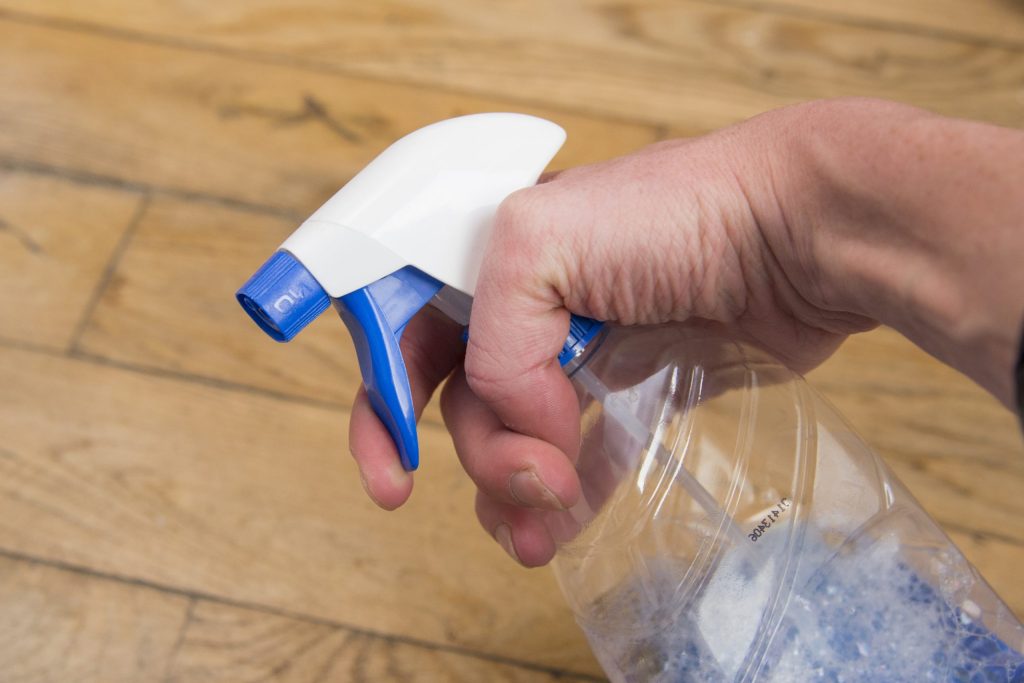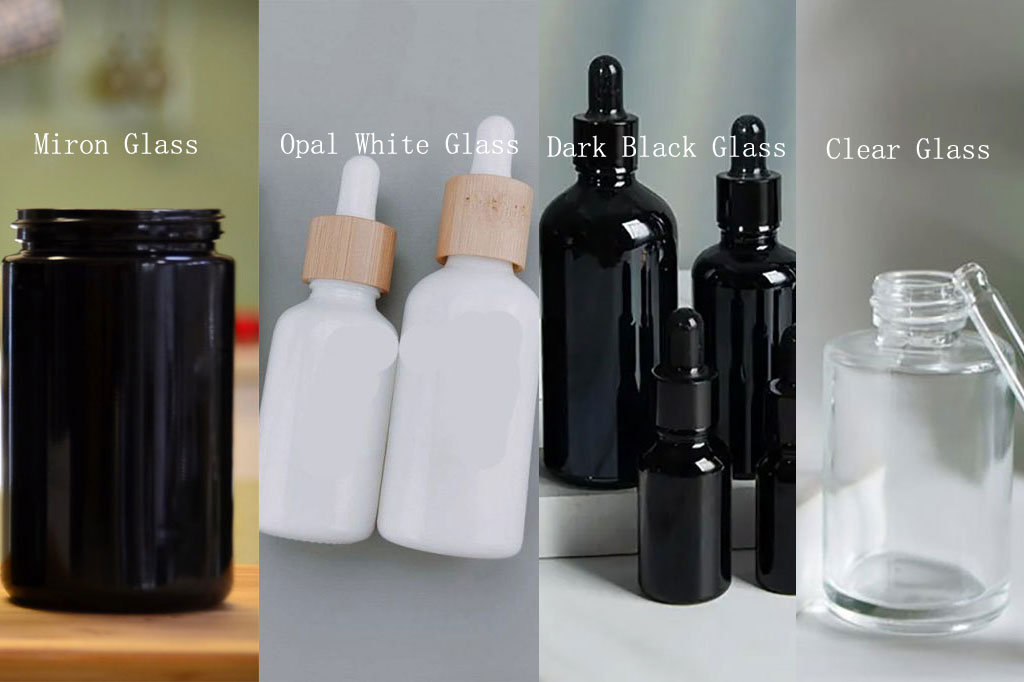In the world of skincare and cosmetics, packaging does far more than simply hold a product—it defines how consumers interact with it. The size and type of dispenser you choose can affect not only usability and product preservation but also a brand’s environmental footprint, cost structure, and market positioning. A lotion that feels luxurious but is packaged in an inconvenient or wasteful container risks losing consumer trust. Conversely, a well-designed bottle with the right capacity and dispensing system enhances user satisfaction and extends product longevity.
This complete guide explores the wide spectrum of lotion bottle sizes, dispenser types, and their best use cases, providing insights that help skincare brands, developers, and consumers make informed decisions about packaging that’s both functional and beautiful.
Understanding Lotion Bottle Sizes
The Role of Size in Product Strategy
Lotion bottle size isn’t a simple matter of volume; it reflects branding strategy, consumer behavior, and product economics. Size determines usage patterns—travel convenience, daily application, or professional use—and influences perceptions of value and luxury. For manufacturers, it impacts supply-chain costs, labeling, shipping logistics, and retail display optimization.
Broadly, lotion bottles fall into five main size categories: mini/travel, standard daily-use, large household, professional/salon, and bulk refill.
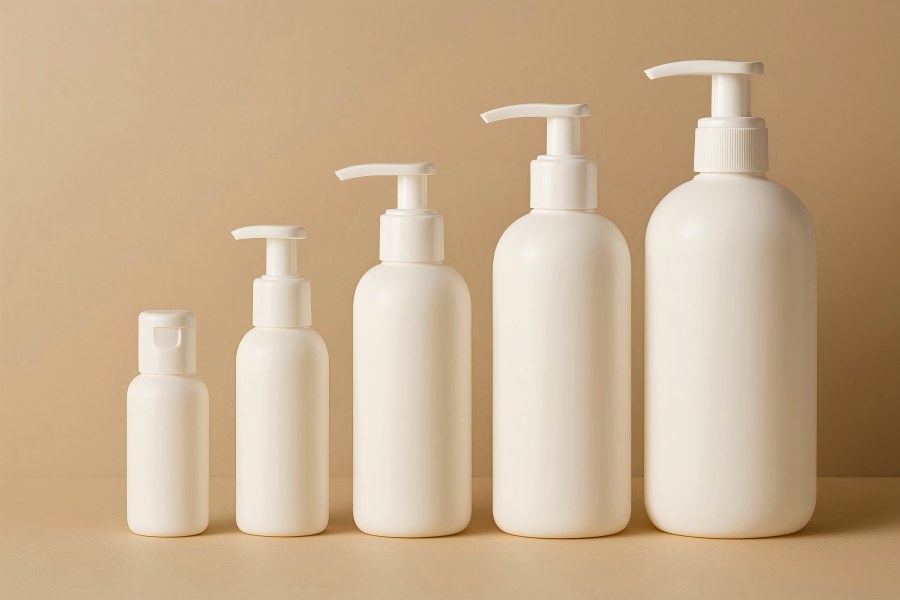
Mini or Travel-Size Bottles (10–50 ml)
These are the smallest category, designed primarily for portability and regulatory compliance with airline liquid restrictions (typically 100 ml max per container).
Common uses include:
- Hotel amenities and travel kits
- Sample distributions for product trials
- On-the-go skincare essentials such as hand lotion or sunscreen
Material trends:
- PET and HDPE plastics for lightness and durability
- Increasing adoption of refillable or recyclable options
Dispensing systems:
- Flip-top caps and mini pumps for hygiene and controlled dispensing
Advantages: Portability, low cost, easy sampling.
Limitations: High packaging-to-product ratio, less eco-efficient in large quantities.
Standard Daily-Use Bottles (100–250 ml)
This range covers most commercial skincare and cosmetic products. It balances usability and convenience, suitable for lotions, creams, body moisturizers, and sunscreens.
Best applications:
- Everyday hand and body lotions
- Moisturizing and medicated formulations
- Facial products designed for consistent home use
Packaging insights:
- 120 ml, 150 ml, and 200 ml are the most popular retail sizes globally
- Transparent PET or frosted glass enhances shelf appeal
- Pump dispensers or disc caps improve controlled application
Brand note: Premium brands often choose heavier glass or airless pump bottles, conveying a sense of luxury and protection from oxidation.
Large Household Bottles (300–500 ml)
As families and households increasingly prefer value-sized packaging, 300–500 ml bottles cater to prolonged use and reduced plastic waste per unit volume.
Common markets:
- Body lotions for family use
- Baby care moisturizers
- After-sun and aloe-based formulations
Key characteristics:
- HDPE or PP (polypropylene) bottles for resilience
- Pump or squeeze-top mechanisms for quick application
- Ergonomic bottle design to ensure grip and stability
Sustainability trend:
- Refill pouches or recyclable PETG versions are replacing rigid plastic bottles, allowing consumers to refill the same dispenser multiple times.
Professional or Salon Bottles (500–1000 ml)
Salons, spas, and clinics require larger lotion bottles for frequent use. A 750 ml to 1 L capacity is typical for massage oils, moisturizing creams, or post-treatment products.
Functional priorities:
- Efficient pumping action and easy refilling
- Stable, wide-bottom bottles for workstations
- Compatibility with labeling and measurement requirements
Material and dispensing innovations:
- Sturdy PET or HDPE with industrial-grade pump mechanisms
- Lockable or directional pumps to prevent leakage during transport
This segment emphasizes durability, hygiene, and efficiency, often prioritizing function over aesthetics.
Bulk Refill and Eco-Friendly Sizes (1–5 Liters)
Bulk sizes have gained popularity in both professional and household contexts as part of the refill and sustainability movement.
Market drivers:
- Reduction in packaging waste
- Cost efficiency for frequent users
- Growing consumer preference for refillable systems
Dispensing mechanisms:
- Detachable pump heads or spigots
- Compatible with smaller refillable bottles
Common use: Lotion refills for spa chains, hotels, or eco-conscious brands offering closed-loop packaging systems.
Common Lotion Bottle Materials Across Sizes
Though this guide focuses on sizes and dispensers, material compatibility is crucial for ensuring safety, quality, and recyclability.
| Material | Properties | Best For | Environmental Impact |
| PET | Clear, lightweight, strong | Retail skincare bottles | Fully recyclable; popular for aesthetics |
| HDPE | Opaque, chemical resistant | Industrial or family-sized lotions | Widely recycled; durable |
| PP | Resistant to stress and cracks | Pump mechanisms, caps | Recyclable but less common |
| Glass | Premium and inert | High-end cosmetic products | Reusable; energy-intensive to produce |
| Aluminum | Lightweight, fully recyclable | Sustainable packaging trends | Excellent barrier; eco-friendly |
A perfect bottle combines the right material + size + dispenser type, balancing form, function, and sustainability.
Lotion Bottle Dispenser Types and Their Mechanisms
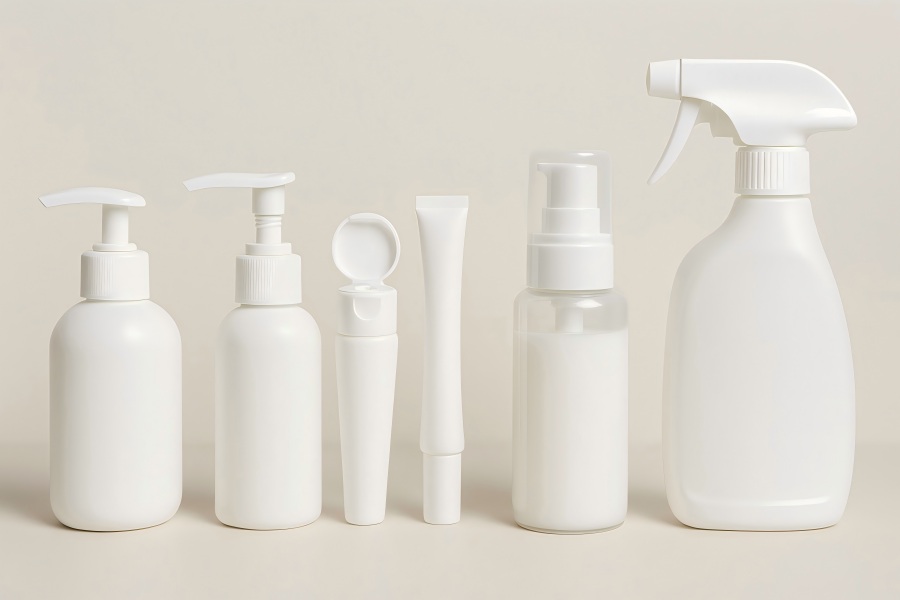
The dispenser is the functional core of a lotion bottle. It defines user experience, hygiene, product waste levels, and even perceived brand value. Below are the most common dispenser types and their advantages.
Pump Dispensers
The most widely used mechanism for medium to large lotion bottles, pumps deliver consistent doses with minimal effort.
Types of Lotion Pumps
- Standard pump: Common for 200–500 ml bottles; delivers ~2 ml per press.
- Locking pump: Ideal for travel or retail packaging; twist-to-lock design prevents leakage.
- High-output pump: Used for salon or industrial lotion containers (1–5 L).
- Airless pump: Designed for premium or sensitive formulations requiring minimal air exposure.
| Pros | Cons |
| Precise dosage control | Limited recyclability due to mixed components |
| Hygienic, one-hand operation | May not suit highly viscous or oily formulas without specialized tubing |
| Minimal contamination or oxidation |
Flip-Top and Disc-Top Caps
Flip-top caps are widely used for small to medium bottles (100–250 ml) and provide a simple, cost-effective way to dispense lotion without pumps.
Design benefits:
- Compact and easy to open with one hand
- Controlled dispensing for semi-liquid lotions
- Ideal for travel-size or mass-market products
Disc-top variation: The top surface presses inward to reveal a small dispensing orifice—offering better control and spill prevention.
Key uses: Hand creams, sunscreens, after-sun lotions, or daily moisturizers.
Squeeze Tubes
Though not technically “bottles,” squeeze tubes deserve mention for their role in lotions and gels under 200 ml.
Material composition: LDPE (Low-Density Polyethylene) or laminated multi-layer structures ensuring flexibility and airtightness.
| Pros | Cons |
| High portability and minimal product exposure | Difficult to refill |
| Excellent for viscous lotions or medicated creams | Often non-recyclable due to multi-layer materials |
| Compatible with various caps |
Squeeze tubes appeal to individual consumers who prioritize convenience and single-handed application.
Airless Bottles
Airless bottles are engineered for maximum product preservation. They use a piston mechanism to push the lotion upward without letting air back in.
Applications: High-value or sensitive formulations—anti-aging creams, vitamin serums, or organic lotions.
| Pros | Cons |
| Prevents oxidation and microbial contamination | Higher production cost |
| Dispenses nearly 100% of product (no leftover waste) | Complex recycling process |
| Luxurious feel suitable for high-end markets |
Airless systems are a hallmark of premium skincare packaging, combining performance, aesthetics, and functionality.
Trigger Sprayers and Mist Pumps
Used primarily for light lotions, sprays, and toners, these mechanisms deliver fine or coarse mist depending on nozzle design.
Categories:
- Fine mist sprayer: For facial mists or moisturizing toners
- Lotion spray trigger: For sun lotions or body mists
- Adjustable nozzle sprayer: Allows variable output flow
Material: PP or PET, often integrated into ergonomic handles for 300–500 ml bottles.
| Pros | Cons |
| Large coverage area | Not ideal for thick lotions or creams |
| Adjustable delivery style | Requires specific viscosity adjustment |
| User-friendly for repeated use |
Screw Caps and Refill Closures
Screw caps are among the oldest yet most reliable closure types. They are common for bulk refills or minimalist designs, providing airtight protection.
Variants:
- Simple screw cap
- Tamper-evident closure (for sealed products)
- Child-resistant or pressure-seal options
Ideal applications: Lotion refills, DIY skincare, or eco-friendly zero-waste packaging systems.
Choosing the Right Dispenser for Product Type
Selecting the right dispenser depends on the formulation’s viscosity, target audience, and usage scenario.
| Lotion Type | Viscosity Level | Recommended Dispenser | Bottle Size Range |
| Facial moisturizer | Low–medium | Airless pump or disc-top | 50–150 ml |
| Body lotion | Medium | Standard pump | 200–500 ml |
| Hand cream | High | Flip-top or squeeze tube | 100 ml |
| Baby lotion | Medium | Pump or squeeze | 300–500 ml |
| Professional massage lotion | Low–medium | High-output pump | 750–1000 ml |
| Organic/natural lotion | Medium | Airless or glass pump | 100–250 ml |
| Sunscreen or after-sun lotion | Low | Flip-top or spray | 100–300 ml |
| Refill lotion | Any | Screw cap or spigot | 1–5 L |
By aligning dispenser technology with lotion texture and consumer habits, brands optimize both performance and satisfaction.
Factors Influencing Size and Dispenser Selection
Product Formulation and Viscosity
Thicker lotions need pumps with wider orifices, while lightweight, watery formulas can use fine mist sprayers. Viscosity determines tubing diameter, spring tension, and nozzle design.
Brand Positioning
Luxury skincare brands often use glass airless pumps for perceived purity and aesthetic value. Mass-market brands prioritize cost-effective PET bottles with standard pumps or flip-tops for accessibility.
Consumer Lifestyle
Modern consumers demand portability, hygiene, and sustainability. Smaller refillable travel bottles and bulk refill stations support zero-waste lifestyles, while hygienic pump dispensers cater to family use.
Market Regulations
Some countries regulate packaging volume for certain product categories (e.g., 100 ml carry-on liquid rules for air travel). Compliance with FDA, EU, or REACH packaging safety standards is mandatory for export markets.
Sustainability and Circular Design
Eco-conscious design trends include:
- PCR (Post-Consumer Recycled) plastics
- Mono-material pumps for recyclability
- Aluminum or bioplastic alternatives
- Refill pouch systems
Brands now integrate LCA (Life Cycle Assessment) metrics when choosing size and material to quantify environmental impact.
Design and Ergonomics
Beyond functionality, ergonomics drives consumer experience.
Key aspects include:
- Grip shape: Rounded contours prevent slippage during use.
- Transparency: Lets consumers monitor remaining product.
- Neck size and thread type: Must match dispenser specifications.
- Label area: Sufficient for branding, ingredients, and usage info.
- Balance and stability: Important for large bottles and pumps.
A well-engineered bottle ensures comfort, precision, and durability, improving product perception and reducing accidental waste.
Innovations in Lotion Bottle Design
Smart and Sustainable Packaging
Refillable cartridge systems: Brands like Dove and L’Occitane are introducing reusable metal bottles with refill pouches.
- Smart dispensers: IoT-enabled pumps track product usage and send refill reminders.
- Compostable bioplastics: PLA-based packaging now supports low-viscosity lotions.
Airless + Refill Hybrid Models
Hybrid airless systems combine refillable inner cartridges with external durable housings—offering both product protection and environmental responsibility.
Minimalist and Transparent Aesthetic
Modern consumers associate transparency and simplicity with purity. Hence, clear PET bottles with minimal labeling are trending across eco-conscious and luxury lines alike.
Cost and Manufacturing Considerations
Tooling and Mold Costs
Each size or dispenser type requires a unique mold, influencing startup investment and MOQ (minimum order quantity).
Supply Chain and Logistics
Smaller bottles reduce shipping efficiency due to higher packaging-to-product ratio. Conversely, large bottles need reinforced packaging to prevent damage during transit.
Customization Options
Brands often request custom bottle shapes, color gradients, or UV coatings. These enhance recognition but affect recyclability.
Regulatory Labeling
Each bottle size must accommodate mandatory labeling—ingredients, net volume, manufacturer details, expiration dates—without crowding the design.
Practical Guidance for Brands and Manufacturers
Step 1: Identify Target Market and Usage
Determine whether the product is for individual, household, or professional use.
Step 2: Match Formulation to Dispenser Type
Thicker formulations need high-viscosity pumps; lightweight lotions suit flip-tops or sprays.
Step 3: Select Bottle Size Based on Use Frequency
Estimate consumption rate: daily-use body lotion (200–300 ml), professional lotion (1 L), refill (3–5 L).
Step 4: Prioritize Sustainability
Choose recyclable materials (PET, HDPE, aluminum) and modular components for easy disassembly.
Step 5: Prototype and Test
Check dispenser compatibility, leakage resistance, ergonomic comfort, and shelf presentation before mass production.
Global Market Trends
- Refillable beauty packaging projected to grow by 15% annually (2024–2030).
- Airless pump market expanding due to demand for preservative-free formulas.
- PETG and PP recyclability advancements improving circular economy feasibility.
- Customization and branding remain key differentiators—brands invest in embossed logos, unique bottle silhouettes, and metallic finishes.
In Asia, compact sizes (100–150 ml) dominate; in North America and Europe, pump bottles (250–500 ml) remain standard. Emerging eco-markets increasingly favor refill pouches and biodegradable containers.
Maintenance and Consumer Tips
For end-users:
- Keep pumps clean: Regularly wipe nozzles to prevent clogging.
- Store upright: Especially for airless and pump bottles.
- Recycle correctly: Remove metal springs or mixed-material components before recycling.
- Refill smartly: Use funnel systems or refill stations to avoid contamination.
Proper maintenance extends packaging lifespan and supports environmental goals.
Future Outlook
The future of lotion packaging lies in integration and intelligence—combining ergonomic design, environmental responsibility, and digital functionality.
Expect to see:
- Smart refill stations in retail environments
- Recycled content mandates from governments
- Consumer incentives for returning used packaging
- Material traceability using blockchain technology
Innovation will continue focusing on closed-loop packaging, reducing carbon footprint while preserving product integrity.

